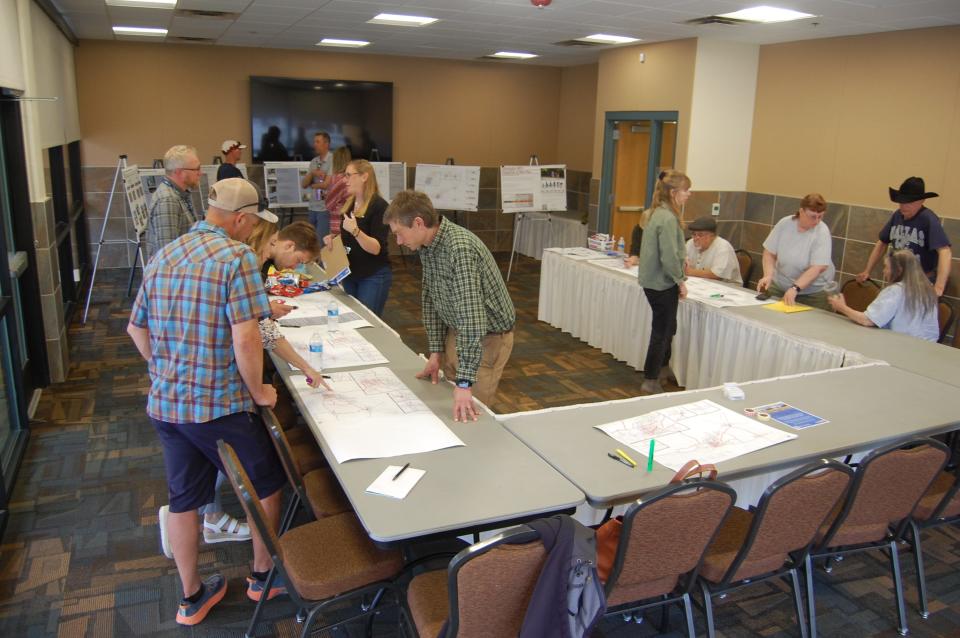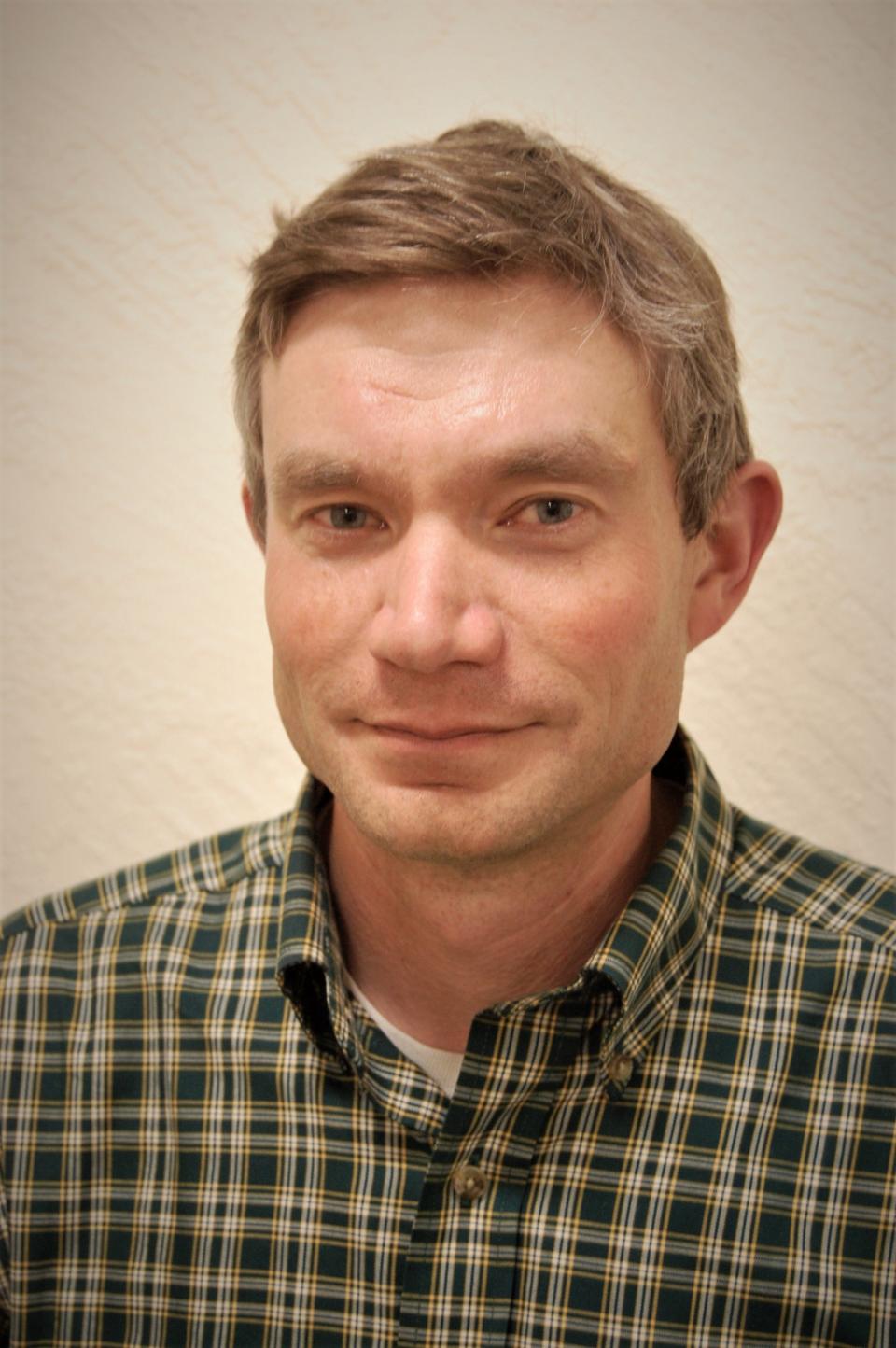Frustrations aired during Civic Center meeting on pedestrian-bicycle plan update
An April 12 meeting at the Farmington Civic Center that was intended to serve as a chance for organizers to update citizens on the status of an update to a bicycle and pedestrian master plan for the region quickly wound up highlighting the frustrations that different road and trail users have with each other.
The event was the second public meeting that the Farmington Metropolitan Planning Organization — a regional group responsible for transportation planning for the communities of Aztec, Bloomfield, Farmington, Kirtland and other urbanized areas of San Juan County — has held as part of the process of updating the plan, which is designed to make recommendations and identify infrastructure priorities for nonmotorized forms of transportation. Also taking part in the meeting were representatives of the Toole Design Group, the national design firm hired by the Farmington MPO to help put together the plan.
The process began last fall, and organizers are still gathering input from members of the public about what changes they would like to see. They got plenty of feedback from the more than one dozen people who attended the April 12 meeting, as a number of grievances were aired about the often-tense interactions between motorists, cyclists and walkers navigating the same roads or trails.
One bicyclist who attended the meeting likened the situation to Farmington to “the Wild West,” while Chris Conley, the vice president of Farmington Area Single Track, a nonprofit group that advocates for the preservation, construction and maintenance of nonmotorized single-track trails in the area, said he has been spat at and had things thrown at him my motorists who don’t like sharing the road with him.

“You name it, it’s happened to me in this town,” he said.
Others at the meeting placed much of the blame on the cyclists themselves for not following the rules of road, while one woman in attendance expressed the idea that there seems to be a government conspiracy afoot to force people out of their cars and onto bicycles.
Conley said building a culture in San Juan County in which everyone is more tolerant and respectful of those using various forms of transportation is a gradual process and will take some time.
“We’re building the necessary relationships to make this shift in the county,” he said after the meeting. “This won’t be an overnight thing. It’s going to take all those things to make it happen.”
Aaron Sussman of the Toole Design Group noted that the costs of transportation are growing at the same rate or even faster than housing costs are across the United States, meaning that more and more people likely are begin exploring using a bicycle or their feet to get around.

“One of the things we’re talking about is, are there lower-stress options to get to schools or parks?” he said.
Max Gallegos, a lifelong bike rider who retired from the San Juan Generating Station, said his main concern is other trail users who simply don’t understand or respect common etiquette. He said he regularly encounters joggers in headphones who can’t hear him approaching them from behind, leading to near collisions, even when he does his best to give them a wide berth. He also complained about people walking dogs who use extendable leashes, which can allow those animals to run into the path of passing cyclists.
“People are oblivious,” he said after the meeting. “ … It’s not always easy (for a cyclist) to stop on a dime on those (unpaved) surfaces.”
Evan Pilling, Farmington’s new outdoor recreation manager who recently moved here from Tucson, said that city experienced many of the same conflicts between motorists, bicyclists and walkers. When Gallegos advocated for increased signage advising various users about how to properly share trails or roads, Pilling said his experience has been that signs are widely ignored.
“The more signs you have, the more people are not going to read them,” he said.
Pilling said city officials in Tucson instead initiated a program in which volunteers wearing trails ambassador T-shirts were present at the city’s busiest trails on evenings and weekends, offering tips on trail etiquette when they saw someone doing something dangerous or inappropriate.
“That’s one of the components I’m in the process of proposing here,” he said.
But Gallegos was skeptical such an approach would work over the long term.
“That’s a good thing if you have enough volunteers,” he said. “It’s a good idea for awhile, but it loses interest.”
Still, Gallegos said he appreciated the way his concerns were listened to and addressed during the meeting. He, too, acknowledged that conflicts between road and trail users are inevitable when use goes up and congestion increases.
Sussman, whose company works with communities all around the country on similar plans, said it is not unusual to hear about such conflicts when public meetings are held.
“I think the reality is that changing roadway design can be kind of scary,” he said. “But the point we want to emphasize is that this is about creating options.”
Conley said his group has been active for four and a half years and has more than 1,200 Facebook followers. He said his impression is that enthusiasm for more bike trails and bike lanes in San Juan County is rapidly growing and that even more people would be using a bike to get around if they thought it was safer to do so.
“The community support we’ve received in everything we’ve been doing has been tremendous,” he said. “It’s mind blowing how much support the community is offering us.”
Peter Koeppel of the Farmington MPO said the organization is committed to making biking and walking as safe as possible for people of all ages and abilities. But he noted the responsibility for making that happen falls on everyone.
“Education is an important part of walking or biking, just like any other mode of transportation,” he said. “We expect cyclists to follow the rules of the road.”
He said an online survey the organization conducted drew approximately 200 responses, with local residents expressing their preferences for where they would like to see more trails, bike lanes or other infrastructure for nonmotorized forms of transportation.
Sussman said that was a higher level of response than his company has received in other communities, and he said he thinks that reflects how much interest there is in San Juan County in nonmotorized transportation options.
He made sure to remind the group that adding bike lanes doesn’t always mean tearing up existing roads and rebuilding them. He said existing bike lanes easily can be widened by a foot or two during repaving and restriping work that most cities do during the summer without noticeably reducing the size of driving lanes. That wider barrier goes a long way toward making many cyclists feel safer, he said, and it also helps pedestrians using adjacent sidewalks feel further removed from traffic, enhancing their experience.
“It can be very inexpensive to implement or enhance bike lanes across a city,” he said.
Sussman also noted that the Farmington MPO is a planning organization and lacks the ability to implement policy. The plan that is being developed will be shared with the organization’s member cities, but it will be up to elected officials in those communities to act on them, he said.
Koeppel and Sussman both said the effort to finalize the new plan remains on track for completion by the end of this summer. Once the process of soliciting public input has been completed, organizers will set about identifying places where new or enhanced infrastructure could be located.
To learn more about the plan update, visit https://bit.ly/fmpobikeped.
Mike Easterling can be reached at 505-564-4610 or measterling@daily-times.com.
Support local journalism with a digital subscription: http://bit.ly/2I6TU0e.
This article originally appeared on Farmington Daily Times: Bicycling safety concerns expressed during plan update meeting

